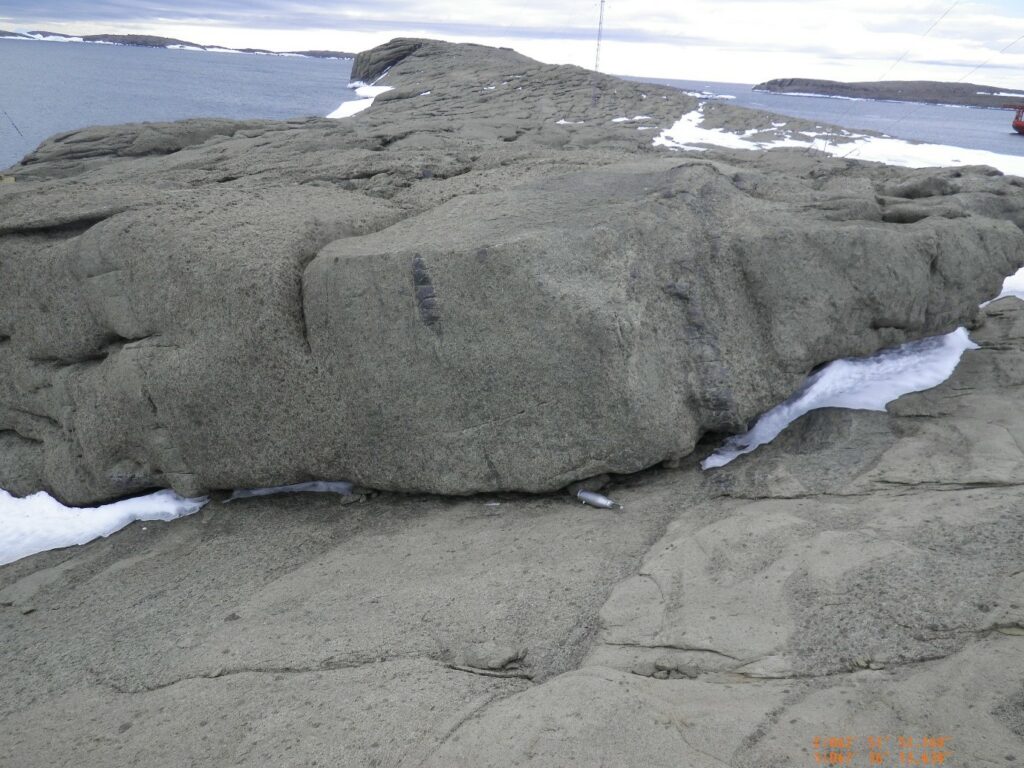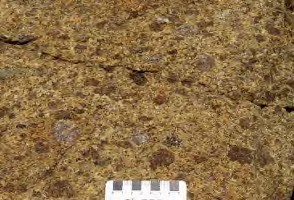
Introduction
The Mawson Charnockite is named after the rock type—charnockite—and the Australian Antarctic Research Station, Mawson, where it occurs. The station, established in 1954, was the first of three permanent Australian bases in Antarctica and is named after Sir Douglas Mawson (1882–1958), Australia’s most famous Antarctic explorer.

The NRG’s two charnockite specimens were collected from outcrops at Mawson Station to commemorate the 65th anniversary of its establishment.

Mawson was a geologist who began his career with an expedition to Vanuatu in 1903, then became a lecturer at the University of Adelaide in 1905. He first went to Antarctica with Sir Ernest Shackleton’s Nimrod Expedition (1907–1909) and with his mentor Edgeworth David and Alistair Mackay was the first to climb to the summit of Mount Erebus and to reach the South Magnetic Pole. He then led the Australasian Antarctic Expedition (AAE, 1911–1914) and the British, Australian and New Zealand Research Expedition (BANZARE, 1929–1931). He described his experiences on the AAE, including a heroic field traverse where his two companions perished, in his book The Home of the Blizzard.
He was knighted in 1914, returned to the University of Adelaide in 1919 and was promoted to Professor of Geology in 1921. He published important works on the geology of South Australia as well as results from his Antarctic work.

DID YOU KNOW?
The unusual name ‘charnockite’ is derived from a polished and engraved tombstone made from dark greenish rock which was mined from St Thomas Mount near Chennai. That rock was named charnockite to honor Job Charnock, an employee of the English East India Company.
Geological overview
Charnockite—used for the gravestone of Job Charnock in Kolkata, India—was first identified and described by the then director of the Geological Survey of India (Sir Thomas Holland) in 1893. It originated from a source in Chennai, 1500km to the south east. Charnockite is a distinctive coarse grained granitic rock composed of quartz, K-feldspar, plagioclase and orthopyroxene (hypersthene), generally found in granulite-facies metamorphic terranes that formed in the dehydrated lower continental crust where intense heat and pressure were dominant. Although many charnockites are metamorphic rocks, some, like the Mawson Charnockite are igneous (crystallised from a melt).

This Mawson Charnockite is a brown, porphyritic (containing crystals of distinctly different size), gneissic (made up of bands of minerals of different composition) rock, with a slight to moderate foliation (layering) and numerous xenoliths (fragments of different rocks which were incorporated into the magma). Its field relations clearly demonstrate its intrusive, magmatic origin. It is notable for the large alkali feldspar crystals.

An example of a xenolith in one of the NRG rocks is shown in the image below.

The Mawson Charnockite has been dated at around 954 Million years. Charnockites are distributed throughout the Precambrian shield areas of the southern continents that formerly made up the southern supercontinent of Gondwana, including Antarctica, South America, Africa, Madagascar, India, Arabia, Australia, New Guinea and New Zealand.
In mainland Australia, charnockites are found near Cape Leeuwin and Cape Naturaliste near Albany, Esperance Bay, Eyre Peninsula, and in the Musgrave Ranges.

About the NRG specimens
Two specimens of Mawson Charnockite were transported by the Aurora Australis to Hobart and stored for 7 months at the Mornington core storage facility run by Mineral Resource Tasmania (MRT).

After funds were raised to cover the costs of the long haul from Hobart to the ACT, the rocks were placed on a truck and moved to the NRG’s rock storage site in Canberra.


Acknowledgements
The NRG Steering Committee is very pleased to acknowledge the support of the Australian Antarctic Division (including the Late Prof. Pat Quilty) for donating these rocks to the National Rock Garden, and for shipping them on the Aurora Australis from Antarctica to Hobart. We also thank the Minerals Council of Australia and Mr Warwick Willmott for two donations which covered all of the transportation costs and the preparation of the specimens for display.
A formal public promotion of the placement of the rocks at the NRG will be conducted in Canberra when they are moved to their final display position in 2023.
Want to know more?
About Douglas Mawson: https://en.wikipedia.org/wiki/Douglas_Mawson
Location of Mawson Station: -67.603007°S, 62.87421°E
Mawson Station information: https://www.antarctica.gov.au/about-antarctica/history/stations/mawson/ and https://en.wikipedia.org/wiki/Mawson_Station
Kilpatrick, J.A., and Ellis, D.J., 1992. C-type magmas: igneous charnockites and their extrusive equivalents. Transactions of the Royal Society of Edinburgh, 83, pp.155-164. https://doi.org/10.1017/S0263593300007847
Kilpatrick, J.A., 1995. The Petrogenesis of Magmatic Charnockites. PhD Thesis, ANU.
Sreejith, C., Del Lama, E.A., & Kaur, G., 2021. Charnockite: a candidate for Global Heritage Stone Resource’ designation from India. Episodes Journal of International Geoscience, IUGS. Article, 44(1) 19-29. https://doi.org/10.18814/epiiugs/2020/0200s11
Young, D.N., 1995. Petrology of the Mawson charnockites, Antarctica. MSc Thesis, ANU. https://doi.org/10.25911/5d67b2180b2a5
Authors
Mike Smith and John Bain of the NRG Steering Committee, with assistance from Philip O’Brien (former Geoscience Australia Antarctic marine researcher) and David Ellis (former Geoscience Australia and ANU Antarctic researcher).




